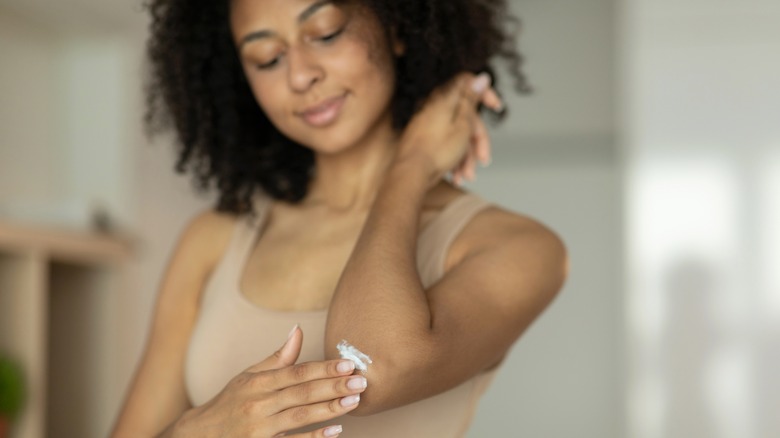The Best Way To Relieve An Itchy Burn Injury
With nearly 2 million people injured annually across the country (via StatPearls), research shows that the vast majority of burns come from thermal sources — 86%, in fact. However, burns can be caused by a number of different things besides fire. X-ray radiation, steam, chemical exposure, hot surfaces, and electricity can also cause one to suffer a burn.
Burns are injuries inflicted to the outer epidermis and/or second layer of skin known as the dermis. When it comes to treatment, a number of factors must be taken into account. This includes the cause of the burn, the percentage of surface area affected, depth, location, as well as the patient's age and health status.
For mild burns, patients should follow the four C's: cooling, cleaning, covering, and comfort. This involves cooling down the skin with tap water, washing the area with mild antibacterial soap and water, applying antibiotic ointment before dressing the wound, and using over-the-counter (OTC) pain-relief medications to manage the discomfort. More serious burns will require emergency medical treatment.
Primary treatment methods for post-burn pruritus
As our skin heals from a burn, itching can be a common side effect. While usually temporary, this is known as central itch — a term used to describe when the body misinterprets an internal itch for a surface itch when it actually stems from the central nervous system (via MedStar Health). A 2020 scientific review published in the International Journal of Molecular Sciences notes that women, patients who have had more surgical treatment, those with burns that cover a greater surface area, and individuals with burns on the face or limbs may be more susceptible to this kind of itching. This is medically referred to as post-burn pruritus.
While more research is needed regarding treatment methods for post-burn pruritus, there are a number of suggested options for patients. This includes the use of oral antihistamine medications as one of the primary treatment methods. However, MedStar Health points out that antihistamine pills aren't always successful. Unlike other kinds of itching, burn-related itching is not caused by the release of histamine in the body. As a substitute, colloidal oatmeal baths or a combined practice of cooling, moisturizing, and massaging the area may be a more effective first-line treatment method.
Alternative treatment options to try
Subsequent treatment methods for post-burn pruritus may include using a topical numbing agent, such as lidocaine. Alternatively, the drug ondansetron (a serotonin-receptor blocker) may also be used. Some research has actually shown it to be more effective than antihistamines.
Another second-line treatment option may be pressure therapy, usually recommended for those who have developed itching related to hypertrophic scarring after a burn. Usually found on tighter areas of skin, experts at Cleveland Clinic explain that hypertrophic scars are thick, elevated scars on the skin's surface that haven't healed smoothly as they normally would. This type of scarring is not uncommon after burn injuries.
MedStar Health says that patients may find certain alternative medicinal treatment methods beneficial as well. This includes hypnosis, acupuncture, and Reiki therapy. While they may not cure the cause of the itching, many of these methods involve redirecting one's attention away from the discomfort.



